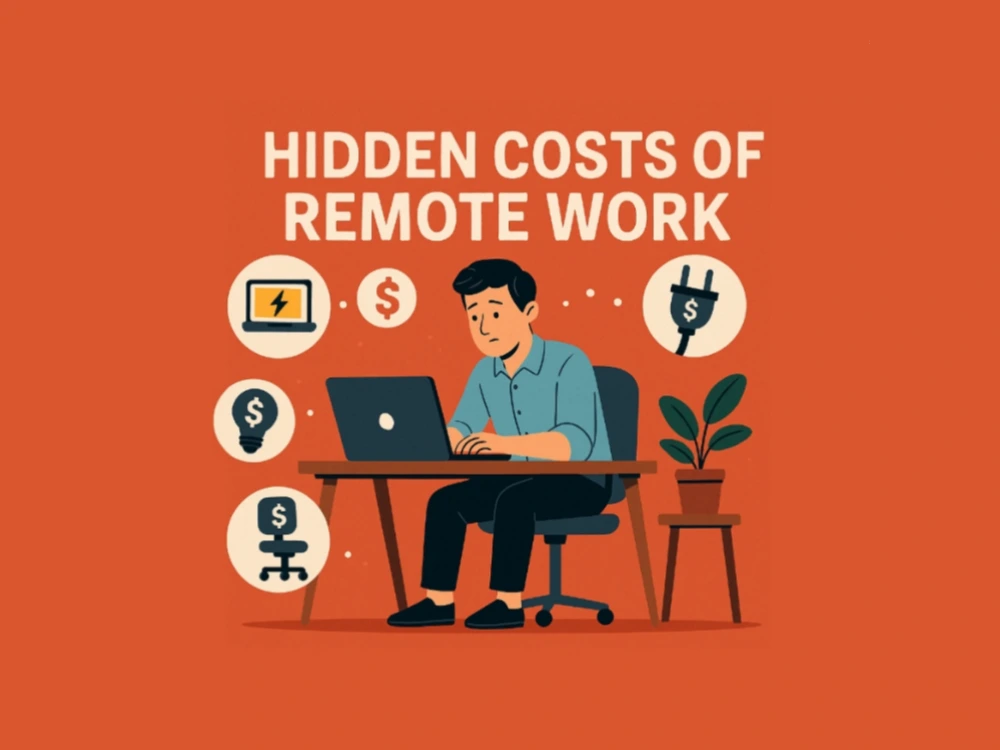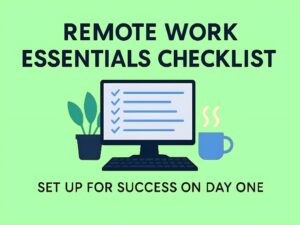Hidden Costs of Remote Work in 2025 | Save Smarter
Remote work sounds like the dream — flexible hours, no commute, and working in sweatpants. But many new (and even seasoned) remote professionals quickly discover the hidden costs of remote work that add up fast. From tech upgrades and utilities to mental health support and workspace expenses, the remote lifestyle isn’t as cheap as it seems. In this guide, we’ll break down those hidden costs, how to avoid them, and how to stay financially smart while working from anywhere in 2025.
1. Upgraded Internet Plans
Most home internet plans weren’t built for video calls, large file uploads, or constant VPN usage. Once you go remote, your standard plan may lag behind — forcing you to upgrade. In places like the UK or US, upgrading to higher-speed broadband can cost an extra $20–$50/month. If you’re a digital nomad, co-working space internet or tethering from your phone adds even more cost.
2. Backup Tech and Repairs
When your laptop is your lifeline, any hardware failure becomes an emergency. Most remote workers eventually invest in a backup device, or at least a second monitor, high-quality webcam, or extra charger. While it feels optional at first, it becomes essential. Tools like these smart freelancer saving tips can help you budget for this in advance.
3. Workspace Setup: Ergonomics Matter
Back pain isn’t a productivity hack. Ergonomic chairs, desks, keyboard trays, and laptop stands can cost hundreds — but they’re non-negotiable for long-term remote work. Many freelancers start by working from their beds or couches. Months later, they pay for it with pain, physiotherapy, and reduced output.
4. Electricity and Heating Bills
Working from home means your heating, cooling, and electricity bills rise — especially during winter or summer. In the UK and parts of Europe, energy prices surged in 2024 and remain high in 2025. Running multiple monitors, lights, and chargers daily? It adds up. Small changes like LED bulbs and smart thermostats help, but expect a noticeable monthly bump.
5. Time Zone Coordination Tools
If you work with international clients or teams, scheduling gets tricky. Tools like Calendly, World Time Buddy, or Clockwise are vital — and most charge for advanced features. It’s one of those hidden costs of remote work no one mentions: staying synced with clients worldwide costs money (and brainpower).
6. Paid Productivity Software
Free tools get you started, but most serious freelancers eventually pay for software like Notion, Grammarly Premium, Descript, or Trello Business. These aren’t just nice-to-haves — they’re part of a functional remote workflow. Want to keep costs low? Check out our guide on free AI tools for freelancers.
7. Burnout and Mental Health Expenses
Remote work can get lonely — especially if you’re in a different time zone or live alone. Therapy apps, meditation subscriptions, and co-working memberships (even just for socializing) are hidden expenses many overlook. And when burnout hits? You might find yourself spending on weekend getaways, massages, or online therapy to cope.
8. Health Insurance and Retirement Contributions
If you’re freelancing full-time, benefits aren’t part of the deal. You’ll likely be paying your own health insurance, retirement savings, and tax filing software. This isn’t just a US issue — freelancers across Europe often lose access to employer-subsidized systems once they go independent.
9. Travel + Remote Work Expenses
Digital nomads often underestimate roaming fees, SIM cards, or short-term housing costs. And the more you move, the more you spend on flexible plans, storage services, and gear replacements. If you’re traveling while working, check out our guide on remote work setups that actually travel well.
10. Taxes, Invoicing, and Legal Fees
As a freelancer or remote contractor, you need to track income across platforms, pay quarterly taxes, and often hire an accountant. In some countries, setting up a business entity is required to work remotely full-time. Legal templates, invoicing tools, and financial advisors become necessary — not optional.
How to Reduce the Hidden Costs of Remote Work
- Use free tools first: Try free plans of Notion, Trello, or Canva before upgrading.
- Automate savings: Use apps like Plum, Revolut, or Acorns to set aside money for gear, taxes, or emergencies.
- Buy smart, not fast: Wait for discounts using tools like CamelCamelCamel or Honey.
- Sell digital products: Offset your expenses by creating and selling templates or guides. Here’s how: Start an AI-powered side business
- Share tools with others: Split costs for subscriptions with friends or teammates (many allow multiple users).
Real Talk: My First Year Remote Was Expensive
When I first went fully remote, I thought I’d save money. But in my first 12 months, I bought a second monitor, upgraded my desk, increased my internet plan, and paid for a VPN, Notion Pro, Grammarly Premium, and Dropbox. I don’t regret it — but I wish I had known. That’s why this article exists: to help you stay ahead of the costs before they surprise you.
Hidden Costs of Remote Work in 2025 (Summary)
The hidden costs of remote work are real — and in 2025, they’re growing. From software and scheduling tools to mental health support and tech replacements, the expenses sneak up. But with a bit of planning, you can reduce or eliminate many of them.
Before You Go: Save More, Earn Smarter
If you’re serious about thriving as a remote freelancer in 2025, don’t just cut costs — get paid faster, find high-paying clients, and unlock app features that pay you.
👉 Want more smart freelancing tips like this? Join our free newsletter and get weekly tools, AI hacks, and digital money tips delivered to your inbox. It’s free, packed with value, and made for remote workers like you.



